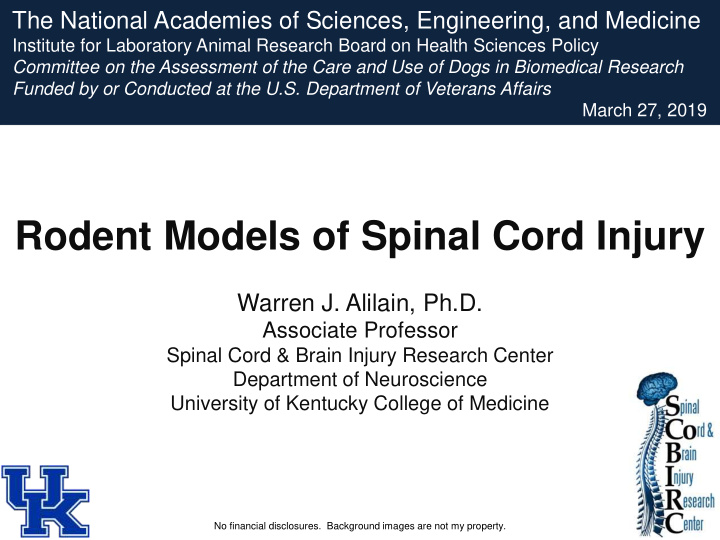



The National Academies of Sciences, Engineering, and Medicine Institute for Laboratory Animal Research Board on Health Sciences Policy Committee on the Assessment of the Care and Use of Dogs in Biomedical Research Funded by or Conducted at the U.S. Department of Veterans Affairs March 27, 2019 Rodent Models of Spinal Cord Injury Warren J. Alilain, Ph.D. Associate Professor Spinal Cord & Brain Injury Research Center Department of Neuroscience University of Kentucky College of Medicine No financial disclosures. Background images are not my property.
Cervical spinal cord injury To put things in perspective: • 291,000 people in the United States have a spinal cord injury (SCI) • There are 17,730 new SCI cases per year • 80% are males • Lifetime costs can exceed $2M • Personal costs to families • >59% of SCI cases are at the cervical level – can result in respiratory motor insufficiency leading to dependence on mechanical ventilators – diminished quality of life National SCI Statistical Center, 2019 Christopher Reeve, 2003
Rodent models in SCI research State of the science: • A majority of the pre-clinical animal SCI research utilizes rodents • Function or outcome measure usually dictates the models utilized – Examples: • forelimb or hindlimb function • pain • autonomic dysreflexia • bladder or bowel movements • Heterogeneity of the injury (level, injury type, time after initial trauma)
Rodent models in SCI research State of the science: treatment outcomes neurotrophic factors ECM modification behavior cell intrinsic systems stem cell relay systems rehabilitation stimulation paradigms injury anatomy • sprouting • synaptic strengthening • plasticity survival • neuroprotection
Cervical spinal cord injury To put things in perspective: • 291,000 people in the United States have a spinal cord injury (SCI) • There are 17,730 new SCI cases per year • 80% are males • Lifetime costs can exceed $2M • Personal costs to families • >59% of SCI cases are at the cervical level – can result in respiratory motor insufficiency leading to dependence on mechanical ventilators – diminished quality of life National SCI Statistical Center, 2019 Christopher Reeve, 2003
Cervical spinal cord injury To put things in perspective: • 291,000 people in the United States have a spinal cord injury (SCI) • There are 17,730 new SCI cases per year • 80% are males • Lifetime costs can exceed $2M effective strategies • neurotrophic factors Personal costs to families ECM modification • >59% of SCI cases are at the stem cell relay systems cervical level rehabilitation – can result in respiratory motor stimulation paradigms* insufficiency leading to dependence on mechanical ventilators • sprouting – diminished quality of life • synaptic strengthening • plasticity National SCI Statistical Center, 2019 Christopher Reeve, 2003
Our laboratory Goal: To effectively model cervical SCI and impaired breathing in order to develop effective therapeutic strategies to promote respiratory motor function To accomplish this, we: • Model chronic Injury • Model Cervical Contusions
Progress made
Our laboratory Goal: To effectively model cervical SCI and impaired breathing in order to develop effective therapeutic strategies to promote respiratory motor function To accomplish this, we: • Model chronic Injury • Model Cervical Contusions • Consider human genetic diversity
Human genetic variance impacting regeneration and plasticity Our experiments in the lab: • inbred rodents – same sex, strain, developmental stage • similar genetic backgrounds
Human genetic variance impacting regeneration and plasticity Reality: Our experiments in the lab: • humans are diverse • inbred rodents • there may be genetic predispositions – same sex, strain, developmental stage or aversions towards regeneration • similar genetic backgrounds and plasticity – this can impact our experimental treatment strategies moving forward towards human application
Considering human genetic diversity “humanized” mouse models: mice with relevant human genes https://www.creative-biolabs.com/drug-discovery/therapeutics/humanized-mouse-models.htm
Breakthroughs in SCI research using rodents To name just a few: • Robust regeneration • Plasticity • Functional stimulation • Impact of the gut microbiome • Secondary complications
The future Rodents in SCI research: Canines in SCI research: • • Already the preferred model Naturally SCI models already for SCI research exist • • Breakthroughs made which Breakthroughs in canine SCI have led directly to human research applicable to both studies (theophylline) dogs and humans • • Genetic tools are readily Spinal cord is accessible in available dogs vs. microsurgery in rodents
THANK YOU
Recommend
More recommend